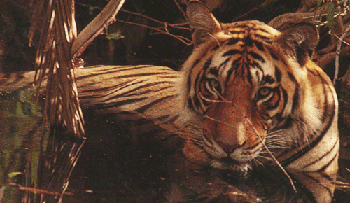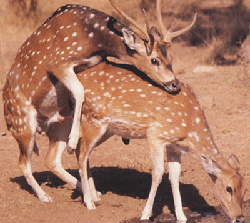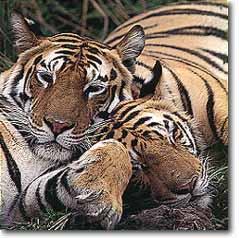|
|
Index ->>
Indian wildlife Tour
Indian Tiger Safari
 Delhi - Khajuraho - Bandhavgarh - Kanha
- Nagpur - Delhi - 08 Days Delhi - Khajuraho - Bandhavgarh - Kanha
- Nagpur - Delhi - 08 Days
 World renowned for its population
of tigers , Kanha National Park provides excellent opportunities
for observing these magnificent animals in the wild on jeep
drives and elephant backs. While this lushly forested country is
immediately familiar to readers of Rudyard Kipling , it has also
recently been the site of extensive research on the ecology of
tiger , deer , languor , Barasingha deer, guar and wild dogs. World renowned for its population
of tigers , Kanha National Park provides excellent opportunities
for observing these magnificent animals in the wild on jeep
drives and elephant backs. While this lushly forested country is
immediately familiar to readers of Rudyard Kipling , it has also
recently been the site of extensive research on the ecology of
tiger , deer , languor , Barasingha deer, guar and wild dogs.
North of Kanha is Bandhavgarh National Park where the first
white tiger was captured and most of the white tigers in
captivity have descended from that tiger. In former times
Bandhavgarh was the exclusive hunting preserve of the Maharaja
of Rewa . Tigers are looked for on elephant back and their
sighting is good. Past history pervades the forest in the form
of an immense sculpture of the Hindu God Vishnu , caves and a
fort. Both the National Parks are countries Prime Tiger Reserve
under Tiger Project.
Not far from Bandhavgarh are the Temples of Khajuraho . they are
master pieces of temple architecture. Of the temples many have
exquisitely and explicitly carved scenes from the Kamasutra.
Built in the 10th to 11th century by the Chandella dynasty ,
they are in a marvelous state of preservation.
Day1: Delhi - Khajuraho:
Transfer to airport for flight to Khajuraho. Situated in the heart of india, in the state of madhya pradesh,
khajuraho is a fascinating village with a quaint, rural ambience
and a rich cultural heritage, honoured by the world as india's
unique contribution to human civilisation. The chandela dynasty
built eighty-five temples here. Only twenty remain as
embodiments of indian architectural and sculptural art. Even ten
centuries after they were constructed, the temples of khajuraho
reflect an eternal philosophy relevant to all mankind. The
temples of khajuraho is a world heritage site and belong not
just to india but to the world. The nearby panna national park
is a project tiger park making the area a unique combination of
outstanding cultural and natural heritage.
Proceed for sightseeing of a group of temples.
Overnight will be at Khajuraho.
 Day 2: Khajuraho -
Bandhavgarh: (By Road 250 km in 5 hr) Day 2: Khajuraho -
Bandhavgarh: (By Road 250 km in 5 hr)
Proceed for morning sightseeing of temples after breakfast.
Drive to Bandhavgarh after lunch.
 Bandavgarh is a new National Park with a very long history. Set
among the Vindhya hills of Madhya Pradesh with an area of 168sq
miles (437sq km) it contains a wide variety of habitats and a
high density of game, including a large number of Tigers. This
is also the White tiger country. These have been found in the
old state of Rewa for Many years. Maharaja Martand Singh
captured the last known in 1951. This white Tiger, Mohun is now
stuffed and on display in the Palace of Maharaja of Rewa. Prior
to becoming a National Park, the forests around Bandavgarh had
long been maintained as a Shikargah, or game preserve of the
Maharaja of Rewa. The Maharaja and his guests carried out
hunting - otherwise the wildlife was well protected. It was
considered a good omen for Maharaja of Rewa to shoot 109 tigers.
His Highness Maharaja Venkat Raman Singh shot 111 Tigers by
1914. Bandavgarh is a new National Park with a very long history. Set
among the Vindhya hills of Madhya Pradesh with an area of 168sq
miles (437sq km) it contains a wide variety of habitats and a
high density of game, including a large number of Tigers. This
is also the White tiger country. These have been found in the
old state of Rewa for Many years. Maharaja Martand Singh
captured the last known in 1951. This white Tiger, Mohun is now
stuffed and on display in the Palace of Maharaja of Rewa. Prior
to becoming a National Park, the forests around Bandavgarh had
long been maintained as a Shikargah, or game preserve of the
Maharaja of Rewa. The Maharaja and his guests carried out
hunting - otherwise the wildlife was well protected. It was
considered a good omen for Maharaja of Rewa to shoot 109 tigers.
His Highness Maharaja Venkat Raman Singh shot 111 Tigers by
1914.
There are 32 hills in this part of the park, which has a large
natural fort at its center. The fort's cliffs are 2625 feet (800
meters) high, 1000 feet (300 meters) above the surrounding
countryside. Over half the area is coverd by Sal forest although
on the upper slope it is replaced by mixed forest of sal, saj,
dhobin, and saja. Winter temperatures (Nov-mid-February) vary
from almost freezing at night to around 68 degree Fahrenheit in
the daytime. Summer nights are also cooler than the daytime
temperatures, which rise to 104 degree Fahrenheit. This park is
closed during the breeding season, which coincides with the
monsoon (July-October). Rainfall in the park averages50 inches
(120cm) per year.
Bandavgarh has been a center of human activity and settlement
for over 2000 years, and there are references to it in the
ancient books, the Narad-Panch Ratra and the Shiva Purana.
Legend has it that Lord Rama, hero of the Hindu epic, the
Ramayana, stopped at Bandavgarh on his way back to his homeland
after defeating the demon King Ravana of Lanka. Two monkey
architects, who had engineered a bridge between the isle of
Lanka and the mainland, are said to have built Bandavgarh's
Fort. Later Rama handed it over to his brother Lakshmana who
became known as Bandavdhish "The Lord of the Fort". Lakshmana is
the particular God of the fort and is regularly worshipped in a
temple there.
The oldest sign of habitation in the park are caves dug into the
sandstone to the north of the fort. Several contain Brahmi
inscriptions dating from the 1st century BC. Various dynasties
have ruled the fort, for example, the Maghas from the 1st
century AD, the Vakatakas from the 3rd century AD, From that
time onwards Bandavgarh was ruled by a succession of dynasties
including the Chandela Kings of Bundelkhand who built the famous
temples at Khajuraho. The Baghel Kings, the direct ancestors of
the present Royal family of Rewa, established their dynasty at
Bandavgarh in the 12th century. It remained their capital till
1617 when the center of court life moved to Rewa, 75 miles
(120Kms) to the north. Without royal patronage Bandavgarh became
more and more deserted until forest overran the area and it
became the royal hunting reserve. This helped to preserve the
forest and its wildlife, although the Maharajas made full use of
their rights. Each set out to kill the auspicious number of 109
Tigers.
At independence Bandavgarh remained the private property of the
Maharaja until he gave it to the state for the formation of the
National Park in 1968. After the park was created poaching was
brought under control and the number of animals rose
dramatically. Small dams and water holes were built to solve the
problem of water shortage. Grazing by local cattle was stopped
and the village within the park boundaries was relocated. The
Tigers in particular prospered and the 1986 extension provided
much needed forest to accommodate them.
Bandavgarh is justifiably famous for its Tigers, but it has a
wide range of other game. The undergrowth is not as dense as in
some northern terai forests, but the best time to see the park
inhabitants is still the summer months when water becomes more
scarce and the undergrowth dies back.
Check in at the resort and overnight will be at Bandavgarh.
Day 3: Bandhavgarh:
A full day game viewing inside the jungle. (Two safaris)
Trip to the Bandavgarh Fort: The oldest fort in India -
considered to be more than 2500 years. One-hour trek up the fort
is worth the effort. The charm of this trek lies in discovering
these monuments in the jungle, unspoiled and unexplored. Some of
the statues lie off the main path and so it is best to take a
guide. Apart from the avatars, well worth seeing are three small
temples of around the 12th century. These temples are deserted
but the fort is still used as a place of worship. Kabir Das, the
celebrated 16th century saint, once lived and preached here. The
natural ramparts of the fort give breathtaking view of the
surrounding countryside. The fort still belongs to the Maharaja
of Rewa and permission is required to visit it. However
permission is available locally and no trip to Bandhavgarh is
complete without making an effort to climb up the fort. The
staff of the resort carries your lunch while you are busy
negotiating the trek to the fort.
Overnight will be at the resort.
Day 4: Bandhavgarh:
Jungle exploration on elephant back and Jeeps. Bird watching and
a walk to the fort.
Overnight will be at Bandhavgarh.
Day 5: Bandhavgarh - Kanha: (By Road 250 km in 5 hr)
 After breakfast drive to Kanha.
This is the place that has been described by RUDYARD KIPLING in
his great book "The Jungle Book". Located in the Mandla district
of Madhya Pradesh, Kanha National Park is a tiger reserve that
extends over an area of over 940 square km. A horseshoe shaped
valley bounded by the spurs of the Mekal presents an interesting
topography. Steep rocky escarpments along the edges offer
breathtaking views of the valley. Realizing the danger on the
Tiger population in the country, the Government started the
"Project Tiger" at Kanha and in 1974 the area was declared a
Tiger reserve. The park is also the habitat of the high ground
Barasingha. After breakfast drive to Kanha.
This is the place that has been described by RUDYARD KIPLING in
his great book "The Jungle Book". Located in the Mandla district
of Madhya Pradesh, Kanha National Park is a tiger reserve that
extends over an area of over 940 square km. A horseshoe shaped
valley bounded by the spurs of the Mekal presents an interesting
topography. Steep rocky escarpments along the edges offer
breathtaking views of the valley. Realizing the danger on the
Tiger population in the country, the Government started the
"Project Tiger" at Kanha and in 1974 the area was declared a
Tiger reserve. The park is also the habitat of the high ground
Barasingha.
In 1930s, the Kanha area was divided into two sanctuaries -
Hallon and Banjar of 250kms to 300kms each. Though one of these
was subsequently disbanded .The area remained a protected one
until 1947. Depletion of the tiger population in the year that
followed led to the area being made an absolute sanctuary in
1952.
Patient watching should reward the visitor, with a sight of
Indian Fox, Sloth bear, Striped hyena, Jungle cut, Lepord, Mouse
Deer, Chausingha or four horned antelope, Nilgai, Ratel and
Porcupine Kanha has some 200 species of birds. Watchers should
station themselves in the hills, where the mixed and bamboo
forests harbour many species and in the grassy forest clearings.
Water birds can be seen near the park's many rivulets and at
Sarvantal, a pool that is frequented by water birds and the area
in front of the museum.
Excursion to Kawardha just east of the Maikala Range (up to
1100m) to the south east of Kanha National Park, Kawardha is a
small town in Chhattisgarh (34 forts) region of M.P. In this
remote area Maharaja Viswaraj Singh has recently opened his
palace to visitors. It provides a delightfully quite unspoiled
contrast with India's big cities and with the much busier
tourist circuit of Rajasthan's 'palace circuit'. This town is in
the center of the Baiga tribe, who live in forest surrounding
the town, and these are several eleventh century temples in the
immediate region.
Reach in the afternoon and relax at the resort.
Overnight will be at the Kanha Resort.
Day 6: Kanha:
Spend the full day viewing game and spotting TIGERS inside the
jungle. (Two safaris)
Overnight will be at the resort.
Day 7: Kanha - Nagpur (By Road 250 km in 6 hr)
Proceed for the morning GAME DRIVE into the forest.
Proceed to Nagpur.
Nagpur, popularly known as Orange Capital of India is also the
second capital of Maharashtra. The Gond King of Deogad, "Bakht
Buland Shah" laid the city's foundation in the year 1702. This
city derived its name from the river Nag that flows through it.
Nagpur was the capital of Madhya Bharat State (C.P. and Berar)
after Indian independence and in 1960, the Marathi majority
Vidarbha region was merged with the new state of Maharashtra.
Overnight will be at Nagpur.
Day 8: Nagpur - Delhi:
Breakfast will be at hotel.
Transfer to airport for flight to Delhi. Reach and transfer to
airport for connecting flight home. If your return flight is
late in the evening we would be organizing a hotel for day use
which can be
 used
for relaxing. used
for relaxing. |





